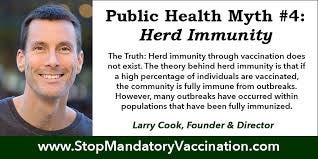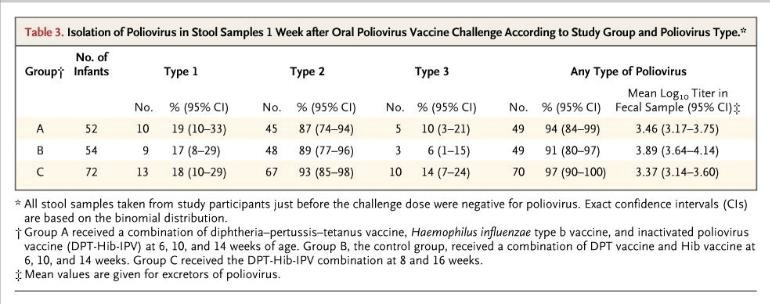Herd Immunity - Truth or Lie?
by Meryl Dorey I remember when it all started. 1978 - two years after High School. While I was riding the subway to college or to work, I would see the billboards and signs -
No Shots, No School!
I remember asking myself - why would anyone not want to vaccinate their children? How many crazy people are there in this world? And I was totally disgusted with the fact that such irresponsible, selfish and most likely stupid people existed. Fast forward ten years to the vaccine injuries of my first child and, not right away, but after years of research, investigation and exhaustive reading, I answered the questions about why anyone would not want to vaccinate their children. And those reasons were scientifically valid and morally responsible. I answered that question in the firm knowledge that my decision would have no effect on anyone else. Except for the fact that I believe my unvaccinated children are far healthier than their fully-vaccinated peers and therefore, we cost the country a fraction of what other families do in healthcare. But I digress... Today, I was interviewed by Radio 4ZZZ in Brisbane about the rallies occurring across Australia this coming weekend to protest against the No Jab, No Pay legislation supposedly being enacted in January 2016.. The interview will be uploaded to the website within the next few days and when it does, you can find it by clicking this link. In that conversation, we spent a lot of time discussing the fact that the government and the medical community are using herd immunity as the reason for insisting that the vaccinated be protected from the unvaccinated.

Herd immunity is a myth. It does not exist. And in fact, the origin of the term had nothing to do with vaccines, disease eradication or even protecting people from infectious diseases. In the 1930s, herd immunity was used to explain why epidemics were cyclical in nature so they could be predicted. The pivotal researcher into this issue described how when a certain percentage of children had contracted and recovered from measles (approximately 66%), there would be a period of 3-4 years before another outbreak occurred. And this was because measles infection gave you something no vaccine ever can - lifelong immunity. How can you possibly have herd immunity from vaccines when vaccines don't convey immunity? It makes no sense! But the government today is saying that our unvaccinated children are somehow maintaining these diseases in the community - diseases that would have been wiped out if it weren't for us refusing to 'do the right thing' and vaccinate. That we are preventing Australia from reaching levels of herd immunity that would see these diseases wiped out - That level being 95%
Where did that 95% figure come from?
When my son was little, the herd immunity figure that we were aiming for was 80%. But we reached 80% pretty quickly and outbreaks were still occurring. Obviously 80% must not have been enough (very scientific, don't you see?) so, hey-presto, it went to 90%. A few years ago, we exceeded 90% but those pesky outbreaks were even worse (especially if we are talking about pertussis - whooping cough). Once again, the level needed to reach herd immunity was increased. Now, we needed to reach 95% before the protection would kick in. The first year we reached that Nirvana level of 95% for whooping cough vaccination was in 2008 - the same year that our current whooping cough epidemic started - an epidemic which is still ongoing and is affecting any country that uses the whooping cough vaccine routinely. There is talk now about herd immunity not being effective until the vaccination rate is 100%. Does the phrase 'moving the goal posts' mean anything to you? So the pollies and health officials who have been out there, pointing the bone at unvaccinated children and telling everyone that 'vaccines only work if everyone does them' are really just trying to cover up the fact that their multi-billion dollar vaccination programs are failing. And whilst many in the community have become sheep-like in regards to this issue, bleating about how our unvaccinated children gave their fully vaccinated little darling the measles, informed parents on both sides of the vaccination divide are refusing to accept such unscientific, illogical nonsense.
Herd immunity does not exist. It is not a 'thing'. It is a lie.

On the radio program, I said that I would post some articles that demonstrate the myth of herd immunity (and coincidentally, a doctor from NSW just posted a comment on this blog the other day trying to convince me that vaccines induce natural immunity!) as well as the fact that those who are vaccinated against pertussis may be more susceptible to pertussis infection than their unvaccinated peers. So here goes. And remember - for those who are reading this and have chosen to vaccinate your children, I support your choice 150%! Just as I expect you to support my right not to vaccinate by the same amount. Freedom only works if everyone gets to use it. Hope to see you all on Sunday at the rallies! Failure of Rubella Herd Immunity during an Epidemic - N Engl J Med 1973; 288:69-72January 11, 1973 The concept that a highly immune group of prepubertal children will prevent the spread of rubella in the rest of the community was shown by this epidemic not always to be valid.
********************************
Duration of effectiveness of pertussis vaccine: evidence from a 10 year community study- Br Med J (Clin Res Ed) 1988;296:612
Thus the pertussis vaccine or its schedule of use does not seem to provide sufficient herd immunity to prevent outbreaks of whooping cough. Matters might be improved if vaccination against pertussis were included in the preschool immunisation programme. (ed note: the medical community's answer to vaccine failure always seems to be - add more vaccines to the schedule. When the preschool booster was added and the rate of pertussis only increased, the only other place to go was to blame the unvaccinated.) ********************************
Herd Immunity and Measles - Clin Infect Dis. (1983) 5 (3): 463-466
The basic concept of herd immunity is directly applicable only under very special conditions. The agents of disease must be restricted to a single host species within which transmission occurs by relatively direct contact, and infection induces solid immunity. Also outbreaks must occur only in randomly mixing populations. In free-living populations, susceptibles are not distributed homogeneously but tend to cluster in subgroups defined by age and by such factors as ethnicity and socioeconomic status. The requisite for occurrence of epidemics, namely a large enough number of susceptibles in frequent contact with each other, exists in virtually all large populations, regardless of the total proportion of the population that is immune. Experience with measles illustrates these conditions. Total prevalence of immunity of ⩾90% in developing countries does not prevent annual epidemics among the susceptibles, most of whom are children younger than three years of age. ****************************** The following is quoted verbatim from Dr Tetyana Obukhanych's open letter to American Lawmakers on herd immunity which you can find linked at the bottom of this post. Randomized controlled trial of inactivated poliovirus vaccine in Cuba. N Engl J Med 356:1536-44 http://www.ncbi.nlm.nih.gov/pubmed/17429085 The table below from the Cuban IPV study documents that 91% of children receiving no IPV (control group B) were colonized with live attenuated poliovirus upon deliberate experimental inoculation. Children who were vaccinated with IPV (groups A and C) were similarly colonized at the rate of 94-97%. High counts of live virus were recovered from the stool of children in all groups. These results make it clear that IPV cannot be relied upon for the control of polioviruses.

****************************** And some information on why those who are vaccinated against pertussis can be more likely to spread and contract the illness than their vaccinated peers: http://www.cdc.gov/maso/facm/pdfs/BSCOID/2013121112_BSCOID_Minutes.pdf Resurgence of Pertussis (p.6) “Findings indicated that 85% of the isolates [from six Enhanced Pertussis Surveillance Sites and from epidemics in Washington and Vermont in 2012] were PRN-deficient and vaccinated patients had significantly higher odds than unvaccinated patients of being infected with PRN-deficient strains. Moreover, when patients with up-to-date DTaP vaccinations were compared to unvaccinated patients, the odds of being infected with PRN-deficient strains increased, suggesting that PRN-bacteria may have a selective advantage in infecting DTaP-vaccinated persons.” ****************************** And why natural infection is far superior to vaccination in terms of protection and duration of resistance to future infection. Warfel et al. (2014) Acellular pertussis vaccines protect against disease but fail to prevent infection and transmission in a nonhuman primate model. Proc Natl Acad Sci USA 111:787-92 http://www.ncbi.nlm.nih.gov/pubmed/24277828 “Baboons vaccinated with aP were protected from severe pertussis-associated symptoms but not from colonization, did not clear the infection faster than naïve [unvaccinated] animals, and readily transmitted B. pertussis to unvaccinated contacts. By comparison, previously infected [naturally-immune] animals were not colonized upon secondary infection.” And lastly, just for fun, are a few mainstream articles - written by doctors and parents - about the myth of herd immunity. Herd Immunity - Junk Science at its Finest Why is China having measles outbreaks when 99% are vaccinated? An Open Letter to Legislators Currently Considering Vaccine Legislation from Tetyana Obukhanych, PhD in Immunology The Deadly Impossibility Of Herd Immunity Through Vaccination, by Dr. Russell Blaylock Please note: Blog posts are opinion pieces which represent the views of the authors. They do not necessarily represent the viewpoints of the nocompulsoryvaccination blog. This blog is a forum, support and information site and outlet for discussion about the relative benefits and risks of vaccinations in particular - and medical procedures in general. We do not provide medical advice but believe that everyone has the opportunity and the obligation to do their own research before making decisions for their families. The information we provide (including your personal review of the references we cite) should be taken in conjunction with a range of other data, including that obtained from government, your health care provider and/or other medical source material to assist you in developing the knowledge required to make informed health choices.



